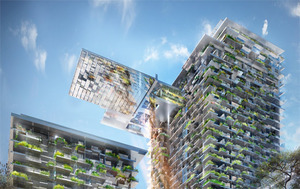Building a high rise development in the centre of a city may not seem the best way to go green – but the designers and developers of Central Park in Sydney say their building will be just as green as any other.
 It used to be an old brewery, but Central Park aims to put the fizz back into green Sydney living
It used to be an old brewery, but Central Park aims to put the fizz back into green Sydney living
Sydney, Australia. 20 June 2011. When it’s finished, Sydney’s Central Park, a mixed-use site on a semi-derelict brewery on the edge of the CBD and just a stone’s throw away from Darling Harbour will have 11 buildings that will be so energy efficient they will be able to export electricity not consume it. Rain will be collected for drinking water, and even grey water will be recycled into usable water.
The US$2 billion, 14-acre high-rise site aims to be a landmark green development in what is already a highly environmentally-aware city. But it won’t be all bells and green whistles, according to Stuart White, a professor at the Institute for Sustainable Futures at the University of Technology in Sydney, an adviser on the project.
 The amazing cantilevered gardens are a major feature of the new development
The amazing cantilevered gardens are a major feature of the new development
“There’s not going to be wind turbines on the roof or even necessarily photovoltaic panels,” he says. Instead, Central Park project will have lots of greenery with hanging gardens and lots of passive energy-saving features cosseting the 1,800 residential units housing about 2,500 people. The key buildings have been designed by French architects Ateliers Jean Nouvel, and feature a cool-looking cantilevered park, way above ground level.
The conventional-looking project uses a “precinct” approach to energy use and conservation. As energy use peaks at different times of the day, and with different usage patterns (office usage rises during the day and residential rises in the evening) the designers have attempted to build in an ability to move energy to where it is most needed at the time.

Plants drape down the exterior of the structures, keeping it cooler and fresher
Heat, mechanical energy and cooling (trigeneration) technology will actually create power, harnessing “waste heat” to significantly raise overall electricity output. This, say the developers, is more efficient than the more common co-generation, which generates only electricity and heat.
Cooling vertical gardens designed by French botanist Patrick Blanc will cover the walls of the residential towers. Recycled sewage will be for watering the gardens and for laundry use, after being processed by a plant in the basement of the old brewery building. This draws water from the sewer mains to filter and treat the sludge, which is then fed back into the greywater system. This is just a part of the plan, say developers Frasers. They see Central Park as an example of what is currently possible using the best methodologies available.
“In most parts of the world people are really disconnected from nature,” said Mr. Blanc, the French designer of the gardens. “The most important is to show that it’s not totally in opposition, the way of life of the human beings and the way of life of the plants.”
Images from the architects